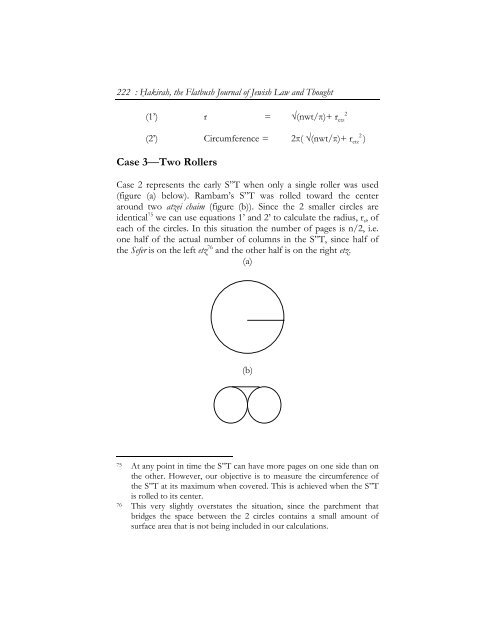Symmetrically Designed Sifrei Torah: A Quantitative Analysis - Hakirah
Symmetrically Designed Sifrei Torah: A Quantitative Analysis - Hakirah
Symmetrically Designed Sifrei Torah: A Quantitative Analysis - Hakirah
You also want an ePaper? Increase the reach of your titles
YUMPU automatically turns print PDFs into web optimized ePapers that Google loves.
222 : Hạkirah, the Flatbush Journal of Jewish Law and Thought<br />
(1’) r = √(nwt/π)+ r etz<br />
2<br />
(2’) Circumference = 2π( √(nwt/π)+ r etz<br />
2<br />
)<br />
Case 3—Two Rollers<br />
Case 2 represents the early S”T when only a single roller was used<br />
(figure (a) below). Rambam’s S”T was rolled toward the center<br />
around two atzei chaim (figure (b)). Since the 2 smaller circles are<br />
identical 75 we can use equations 1’ and 2’ to calculate the radius, r s , of<br />
each of the circles. In this situation the number of pages is n/2, i.e.<br />
one half of the actual number of columns in the S”T, since half of<br />
the Sefer is on the left etz 76 and the other half is on the right etz.<br />
(a)<br />
(b)<br />
75 At any point in time the S”T can have more pages on one side than on<br />
the other. However, our objective is to measure the circumference of<br />
the S”T at its maximum when covered. This is achieved when the S”T<br />
is rolled to its center.<br />
76 This very slightly overstates the situation, since the parchment that<br />
bridges the space between the 2 circles contains a small amount of<br />
surface area that is not being included in our calculations.
















